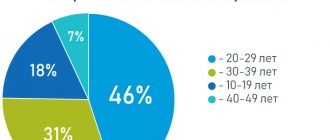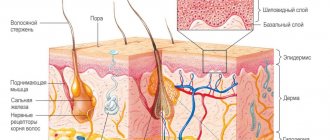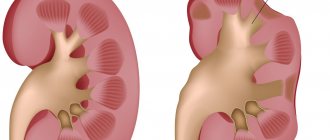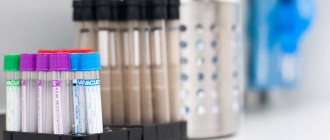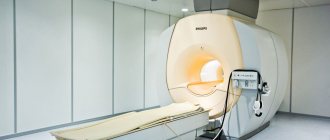Detailed description of the study
Dehydrotestosterone is the active form of testosterone, a male sex hormone related to androgens, which is formed from cholesterol by Leydig cells in the testicles in men, and in small quantities in the ovaries in women.
In peripheral tissues, 60-70% of dehydrotestosterone is formed from testosterone under the action of the enzyme 5-alpha reductase in men, the rest is synthesized directly in the testicles. This hormone performs a number of functions, including:
- participation in sperm maturation;
- regulation of metabolic processes in nervous, muscle, fat and bone tissue;
- stimulation of muscle tissue growth;
- stimulation of the formation of erythrocytes - red blood cells;
- Hair Growth;
- regulation of normal prostate function.
There is androgenetic alopecia, the most common form of alopecia (hair loss), associated with a hereditary predisposition, which affects up to 80% of men and 50% of women during their lifetime. It is characterized by a gradual decrease in the diameter, length and pigmentation of hair. Thinning hair is the result of excess exposure of hair follicles to dehydrotestosterone.
Specialists prescribe the determination of this hormone in the blood before prescribing testosterone therapy for the treatment of male hypogonadism (insufficient amounts of male sex hormones and pathological changes in the genital organs due to this), the study of androgen deficiency in severe diseases, aging and underdevelopment of the penis (microphallus) in infancy.
Dehydrotestosterone has been proposed as an androgen replacement therapy with possible advantages over testosterone in patients with gynecomastia (breast enlargement) and microphallos. Dehydrotestosterone is also determined when prescribing treatment for prostatic hyperplasia with a 5-alpha reductase inhibitor, since the content of this hormone helps to assess the effectiveness of therapy.
However, not only men need to determine this hormone. Hyperandrogenism (excess of androgens, including dehydrotestosterone), one of the common endocrine pathologies in women of reproductive age. In their body, there is excess production of androgens by the adrenal glands and ovaries. Hyperandrogenism is associated with polycystic ovary syndrome (PCOS), the risk of which in women is 7-12%.
Hyperandrogenism is associated with the development of the following diseases and conditions: infertility, endometrial cancer, menstrual irregularities, lipid and carbohydrate metabolism in the body, cardiovascular diseases.
The most common clinical manifestations of hyperandrogenism include hirsutism (excessive male pattern hair growth in women and children), virilization (appearance of masculine features in women), acne vulgaris, and androgenetic alopecia (baldness). Almost 80-90% of women with hirsutism are ultimately diagnosed with hyperandrogenism.
Hirsutism can sometimes be associated with excessive sensitivity of the androgen receptor, but the level of male hormones will be normal.
A test for dihydrotestosterone helps identify the causes of hirsutism and is also important in the diagnosis of hypogonadism, prostate diseases, androgenic alopecia, and gynecomastia.
What is dihydrotestosterone?
The content of the article
Dihydrotestosterone is a hormone that stimulates the development of male qualities (androgen). It is produced by converting the better known androgen, testosterone. Almost 10% of the testosterone produced by adults every day is converted into dihydrotestosterone by the testicles and prostate gland (in men), ovaries (in women), skin and other parts of the body.
However, before puberty the rate is much lower, and it is thought that increased production of dihydrotestosterone may be responsible for the onset of puberty in boys, causing the development of the reproductive organs (penis, testicles and scrotum) and the growth of pubic and body hair.
This hormone also causes prostate growth and is thought to, when combined with testosterone, cause the expression of male sexual behavior. Dihydrotestosterone is many times stronger than testosterone, and many of the effects testosterone has on the body only occur after it is converted to dihydrotestosterone.
Less is known about the importance of dihydrotestosterone for women, but it is known to cause the growth of pubic hair seen in girls after puberty and can help determine the age of puberty in girls.
References
- Marchetti PM, Barth JH. Clinical biochemistry of dihydrotestosterone. Ann Clin Biochem. 2013 Mar;50(Pt 2):95-107. doi: 10.1258/acb.2012.012159. Epub 2013 Feb 21. PMID: 23431485.
- Gorityala S, Yang S, Montano MM, Xu Y. Simultaneous determination of dihydrotestosterone and its metabolites in mouse sera by LC-MS/MS with chemical derivatization. J Chromatogr B Analyt Technol Biomed Life Sci. 2021 Jul 15;1090:22-35. doi: 10.1016/j.jchromb.2018.05.008. Epub 2021 May 16. PMID: 29778874; PMCID: PMC6326363.
- 3. Kim MK, Zhao C, Kim SD, Kim DG, Park JK. Relationship of sex hormones and nocturia in lower urinary tract symptoms induced by benign prostatic hyperplasia. // Aging Male. 2012. Vol. 15, N 2. P. 90-95.
- 4.Li J, Ding Z, Wang Z, Lu JF, Maity SN, Navone NM, Logothetis CJ, Mills GB, Kim J. Androgen regulation of 5α-reductase isoenzymes in prostate cancer: implications for prostate cancer prevention. // PLoS One. 2011. Vol. 6, N 12. P. 28840.
Hyperandrogenism in women. Causes, signs
Hyperandrogenism in women occurs when there is a sharp increase in the level of androgens in the blood serum or when the cells of the sebaceous and sweat glands and ovaries become more sensitive to them. This happens when a woman is diagnosed with the following diseases:
- diseases of the endocrine system;
- tumors of the thymus or thyroid gland, adrenal glands;
- pancreas pathology;
- andrenogenital syndrome;
- increased response to androgen receptors in the skin, sweat and sebaceous glands or ovaries.
Hyperandrogenism in women is observed with the following diseases: multiple ovarian cysts; Stein-Leventhal syndrome, Itsenko-Cushing syndrome, congenital thickening of the adrenal cortex, some tumors characterized by hyperproduction of androgens.
Hyperandrogenism has corresponding symptoms. At puberty in girls, hair growth occurs according to the boy type: hair begins to grow on the face, chest, and along the midline of the abdomen. There is severe peeling of the skin (acne, seborrhea). Deep bald patches begin to appear on the head. For such girls, excess weight becomes a problem. Menstruation begins quite late, and may even be absent altogether. In some cases, menstruation is very short and the gap between them is quite long.
Such women have poorly developed muscles; at a young age, calcium begins to be washed out of the bones and osteoporosis develops. They have reduced glucose tolerance and increased susceptibility to colds.
Increased concentration
Due to the fact that dihydrotestosterone is an active metabolite of the hormone testosterone, their amounts correlate and increase in the following situations:
- Male and female hypergonadism is an excess of sex hormones and associated pathological processes and phenomena.
- Hirsutism is the growth of terminal hair in women along male lines (arms, back, chest, face, groin).
- Ectopic secretion of a hormone or similar substances in tumors of the adrenal glands or gonads.
- Female hyperandrogenism (excess of male sex hormones in the female body).
- A benign prostate tumor is an adenoma.
In addition, the amount of dihydrotestosterone increases during pregnancy.
Reduced dihydrotestosterone levels
It also happens that the hormone dihydrotestosterone is poorly produced in women, its level is much lower than normal.
Dihydrotestosterone levels decrease for several reasons:
- androgen deficiency;
- Morris syndrome (congenital disorders of sexual development).
- diabetes.
A decrease in testosterone and dihydrotestosterone levels can be determined by external signs. For example, in men with a decrease in dihydrotestosterone, hair loss begins, a decrease in muscle mass, disproportionate development of body parts and female-type obesity.
As for women, low levels of dihydrotestosterone are manifested by the following factors:
- libido decreases significantly;
- insomnia, fatigue;
- dry skin.
Important! Only a specialist will be able to determine the true cause of the manifestation of such signs by examining the results of an analysis to determine the level of dihydrotestosterone in a woman’s blood. Perhaps the imbalance of dihydrosterone will not be confirmed.
Norm of dihydrotestosterone in women and men
To determine any abnormalities in the production of dihydrotestosterone in the body of a woman or man, experts use standard indicators. The concentration of dihydrosterone in the female body is determined using a clinical blood test, then the indicators are compared with standard values.
Table of norms for dihydrotestosterone in men and women by age:
| Age, years | Norm for women, pg/ml | Norm for men, pg/ml |
| To 10 | 5-25 | 5-50 |
| 10-12 | 24-450 | 5-50 |
| 13-18 | 24-450 | 250-700 |
| 18-50 | 24-450 | 250-990 |
| Over 50 | 10-181 | 250-700 |
In women of reproductive age, the norm for dihydrotestosterone is considered to be in the range of 24-250 pg/ml , but during the postmenopausal period this figure is slightly reduced. The peak activity of dihydrotestosterone in the body occurs precisely during the teenage transition period, when puberty occurs. At this stage, the level of dihydrotestosterone in the blood is extremely important, since this androgen is responsible for the harmonious development of the body.
Preparing for the test
If you consult a doctor with the symptoms described, he will most likely direct you to take a test to determine the level of dihydrotestosterone in the blood.
In order for the analysis of dihydrotestosterone levels to show the most accurate results, you need to properly prepare for it:
- Analysis of dihydrotestosterone levels in women is best done on an empty stomach. If you can’t do without food, then a person is allowed to drink tea or still water. Dinner on the eve of the study should be light, low-fat and low-calorie.
- Three days before the test for the level of dihydrotestosterone in the blood, you must stop drinking alcohol, smoking and taking strong medications.
- Avoid stressful situations.
- The analysis may give incorrect results if the patient had an ultrasound, x-ray, MRI or massage the day before.
- Be sure to inform your specialist about taking medications, the course of which you do not have the right to interrupt.
When is the best time for women to get tested if they are of reproductive age? When examining the level of dihydrotestosterone in the blood, one should take into account which day of the woman’s cycle falls on that particular day.
It is advisable to carry out the procedure 2-4 days after the start of menstruation. Since the level of hormones associated with reproductive function may vary depending on the phases of the menstrual cycle.
Therapeutic measures
Any hormonal imbalance in a woman requires systemic treatment that will reduce or increase the level of dihydrotestosterone. However, there are also non-pathological reasons for high or low levels of dihydrotestosterone in a woman.
In this case, to eliminate these problems, it takes time (adolescence) and regular consultation with a doctor who will monitor the manifestation of external signs of changes in dihydrotestosterone and will be able to begin timely treatment in case of prolonged imbalance.
Dysfunction of dihydrotestosterone is observed during pregnancy, menopause and taking certain drugs Goserelin, Danazol, Phenytoin and other drugs. The doctor selects medications individually for each patient and depending on the cause of dihydrotestosterone dysfunction in the female body.
Dihydrotestosterone and hair loss are interconnected, since the production of a protein compound depends on the functioning of the hair follicles. Therefore, a woman’s hair begins to thin and fall out. How to lower the level of dihydrotestosterone in this case? To reduce androgen in women, special drugs are prescribed - 5-alpha reductase .
The most common drugs that reduce the level of dihydrotestosterone in the female body are:
Duphaston Finasteride Cimetidine Veroshpiron
Phytoestrogens (phytohormones produced in plants) help reduce the production of dihydrotestosterone: dwarf palm fruits, red clover, soybeans, alfalfa, mint, chamomile, sage.
Nettle , as a type of phytoestrogens, has a beneficial effect on reducing dihydrotestosterone levels in women. Oral contraceptives are also effective in the treatment of normalizing the balance of DHT in a woman’s body: Yarina, Zhanine, Diane-35 .
Important! Medicines that reduce the level of dihydrotestosterone in a woman have a short-term effect, that is, while they are taken.
With polycystic disease, if a woman is planning a pregnancy, the supervising doctor may prescribe the patient ovulation stimulants - solutions for intramuscular use (Puregon, Menogon) or Clostilbegit .
If a woman’s dihydrotestosterone level increases due to the insensitivity of tissue receptors to glucose, then it will be enough to follow a low-carbohydrate diet to lose excess weight. Over time, the hormonal balance will gradually be restored without the use of medications and the level of dihydrotestosterone production will return to normal.
With low testosterone, the doctor usually prescribes hormonal medications that will help replenish the woman’s body reserves.
In some cases, pathologies are incurable, in which case the level of dihydrotestosterone must be constantly monitored with medications.
Hyperandrogenism. Treatment
A woman is primarily concerned about how she looks. In order to relieve the patient of the symptoms of hyperandrogenism, it is necessary to prescribe treatment for the underlying disease that caused the corresponding changes. If she has been diagnosed with polycystic ovary syndrome, then she is prescribed, first of all, medroxyprogesterone, which is especially indicated for hirsutism. Hormonal combined contraceptives reduce hair growth and cure acne in most patients.
Under the influence of these drugs, periods are evened out and blood loss during menstruation is reduced. Hyperandrogenism is also treated with the following drugs: corticosteroids, ketokenazole, spironalactone. For hyperandrogenism with PCOS, surgical treatment is used. Most often, cysts are cauterized using an electrocoagulator.
Treatment of hyperandrogenism with pharmacological drugs for Itsenko-Cushing syndrome is considered a preparatory stage before surgery. The adenoma is surgically removed. Radiation therapy is indicated for pituitary tumors and is not very effective. In the case of congenital adrenal hyperplasia, the only drug used to treat hyperandrogenism is dexamethasone.
If hyperandrogenism in women is caused by hormone-synthesizing tumors, then treatment is usually carried out in oncology centers. The tumor is removed surgically. Surgical treatment is combined with radiation and chemotherapy. Hormonal medications must be prescribed. In case of ovarian hyperplasia, wedge resection should be performed. In severe cases, both ovaries are removed.
